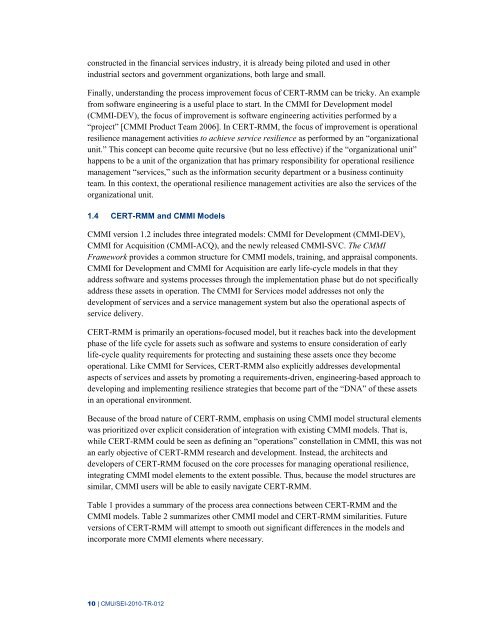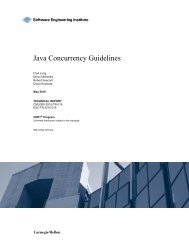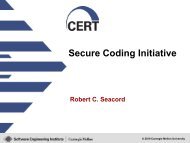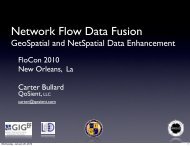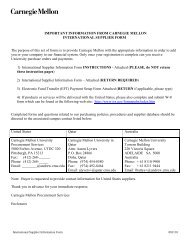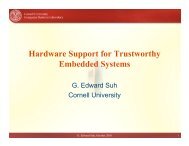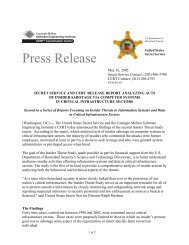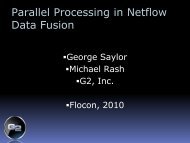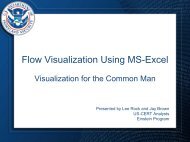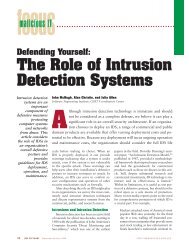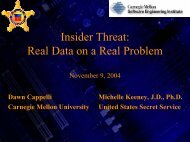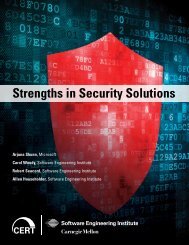CERT Resilience Management Model, Version 1.0
CERT Resilience Management Model, Version 1.0
CERT Resilience Management Model, Version 1.0
- No tags were found...
Create successful ePaper yourself
Turn your PDF publications into a flip-book with our unique Google optimized e-Paper software.
constructed in the financial services industry, it is already being piloted and used in otherindustrial sectors and government organizations, both large and small.Finally, understanding the process improvement focus of <strong>CERT</strong>-RMM can be tricky. An examplefrom software engineering is a useful place to start. In the CMMI for Development model(CMMI-DEV), the focus of improvement is software engineering activities performed by a“project” [CMMI Product Team 2006]. In <strong>CERT</strong>-RMM, the focus of improvement is operationalresilience management activities to achieve service resilience as performed by an “organizationalunit.” This concept can become quite recursive (but no less effective) if the “organizational unit”happens to be a unit of the organization that has primary responsibility for operational resiliencemanagement “services,” such as the information security department or a business continuityteam. In this context, the operational resilience management activities are also the services of theorganizational unit.1.4 <strong>CERT</strong>-RMM and CMMI <strong>Model</strong>sCMMI version 1.2 includes three integrated models: CMMI for Development (CMMI-DEV),CMMI for Acquisition (CMMI-ACQ), and the newly released CMMI-SVC. The CMMIFramework provides a common structure for CMMI models, training, and appraisal components.CMMI for Development and CMMI for Acquisition are early life-cycle models in that theyaddress software and systems processes through the implementation phase but do not specificallyaddress these assets in operation. The CMMI for Services model addresses not only thedevelopment of services and a service management system but also the operational aspects ofservice delivery.<strong>CERT</strong>-RMM is primarily an operations-focused model, but it reaches back into the developmentphase of the life cycle for assets such as software and systems to ensure consideration of earlylife-cycle quality requirements for protecting and sustaining these assets once they becomeoperational. Like CMMI for Services, <strong>CERT</strong>-RMM also explicitly addresses developmentalaspects of services and assets by promoting a requirements-driven, engineering-based approach todeveloping and implementing resilience strategies that become part of the “DNA” of these assetsin an operational environment.Because of the broad nature of <strong>CERT</strong>-RMM, emphasis on using CMMI model structural elementswas prioritized over explicit consideration of integration with existing CMMI models. That is,while <strong>CERT</strong>-RMM could be seen as defining an “operations” constellation in CMMI, this was notan early objective of <strong>CERT</strong>-RMM research and development. Instead, the architects anddevelopers of <strong>CERT</strong>-RMM focused on the core processes for managing operational resilience,integrating CMMI model elements to the extent possible. Thus, because the model structures aresimilar, CMMI users will be able to easily navigate <strong>CERT</strong>-RMM.Table 1 provides a summary of the process area connections between <strong>CERT</strong>-RMM and theCMMI models. Table 2 summarizes other CMMI model and <strong>CERT</strong>-RMM similarities. Futureversions of <strong>CERT</strong>-RMM will attempt to smooth out significant differences in the models andincorporate more CMMI elements where necessary.10 | CMU/SEI-2010-TR-012


